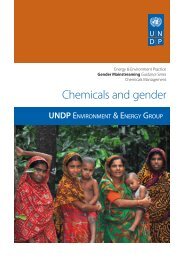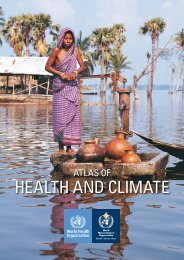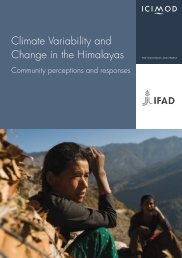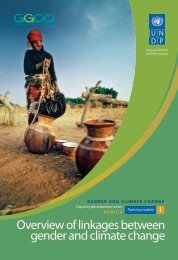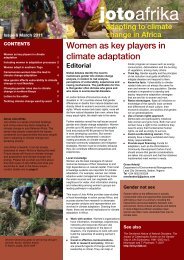Module 4: Gender, Agriculture and Food Security - Gender Climate
Module 4: Gender, Agriculture and Food Security - Gender Climate
Module 4: Gender, Agriculture and Food Security - Gender Climate
- No tags were found...
Create successful ePaper yourself
Turn your PDF publications into a flip-book with our unique Google optimized e-Paper software.
18. <strong>Gender</strong> mainstreaming focuses on the fact that women <strong>and</strong> men experience<br />
life differently <strong>and</strong> have different needs <strong>and</strong> priorities <strong>and</strong> that development<br />
policies <strong>and</strong> interventions affect them differently. The process requires<br />
taking into account several considerations as well as commitment of human<br />
<strong>and</strong> physical resources to produce specific activities, outputs, <strong>and</strong> outcomes<br />
that benefit men <strong>and</strong> women equally. In the context of agriculture <strong>and</strong><br />
food security, it is important that men <strong>and</strong> women of all ages, ethnicities,<br />
religions, <strong>and</strong> socioeconomic levels have enough food <strong>and</strong> especially that the<br />
food be readily available, accessible, <strong>and</strong> appropriately used. <strong>Gender</strong>-based<br />
inequalities along the food production chain ‘from farm to plate’ that impede<br />
the attainment of food <strong>and</strong> nutritional security must therefore be addressed<br />
through effective gender responsive policies, programs, <strong>and</strong> projects (World<br />
Bank 2009). See Figure 4 for a step-by-step process for integrating gender into<br />
agriculture <strong>and</strong> food security policy, projects <strong>and</strong> programmes.<br />
19. Carefully designed policies, strategies <strong>and</strong> projects can work within existing<br />
cultural norms <strong>and</strong> through the public <strong>and</strong> private sectors in ways that benefit<br />
both women <strong>and</strong> men. Many steps are required by many different actors —<br />
governments, civil society, the private sector <strong>and</strong> individuals — but the basic<br />
principles are the same across the board: eliminate discrimination under the<br />
law, make gender-aware policy <strong>and</strong> programming decisions, <strong>and</strong> give women<br />
a greater voice in decision-making at all levels.<br />
Group exercise (see Appendix B: Learning tools)<br />
Summary questions<br />
• Provide some examples of how gender-based constraints in agriculture can<br />
be addressed.<br />
• Mention some ways of mainstreaming gender in agriculture <strong>and</strong> food<br />
security policy, projects <strong>and</strong> programming.<br />
• How does the SADC address gender matters in its Regional Agricultural Policy<br />
18<br />
<strong>Gender</strong> <strong>and</strong> <strong>Climate</strong> Change Capacity development series Afric a<br />
Training module 4 <strong>Gender</strong>, agriculture <strong>and</strong> food security



